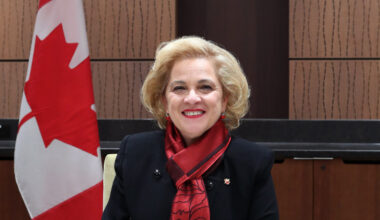Prime Minister Mark Carney has released his first mandate letter to cabinet ministers, and for those following Canada’s immigration policy, the document provides crucial insights into the direction this government plans to take. Unlike previous prime ministers who issued individual mandate letters to each minister, Carney has chosen a unified approach with a single letter outlining seven core priorities for his entire cabinet – with immigration holding a prominent position among them.
A Unified Vision: One Letter, Clear Priorities
In a departure from traditional practice, Carney’s mandate letter represents what he calls “a unified mission” for his government. The single, 800-word document contrasts sharply with the lengthier, individualized letters that characterized previous administrations, signaling a more streamlined and coordinated approach to governance.
For Immigration Minister Lena Metlege Diab and those interested in Canada’s immigration future, priority number six is particularly significant: “Attracting the best talent in the world to help build our economy, while returning our overall immigration rates to sustainable levels.”
This dual-focused directive encapsulates the balancing act that will define Canada’s immigration policy under the Carney government – maintaining Canada’s competitive edge in attracting global talent while addressing domestic concerns about infrastructure capacity and social services.
Breaking Down the Immigration Mandate: Two Pillars of Policy
The immigration priority in Carney’s mandate letter rests on two fundamental pillars that will shape how Canada approaches newcomer selection and integration in the coming years.
Pillar 1: Returning to Sustainable Immigration Levels
The concept of “sustainable” immigration levels has become central to Carney’s political messaging, and the mandate letter reinforces this commitment. But what exactly does “sustainable” mean in practical terms?
During the election campaign, the Liberal Party under Carney’s leadership committed to “stabilize permanent admissions at less than 1% of Canada’s population annually beyond 2027.” With Canada’s population projected to reach 41.5 million in 2025, this translates to approximately 415,000 permanent residents annually.
Interestingly, the targets already outlined in Canada’s 2025-2027 Immigration Levels Plan fall below this threshold:
- 2025: 395,000 permanent residents
- 2026: 380,000 permanent residents
- 2027: 365,000 permanent residents
This suggests that the “return to sustainable levels” may involve maintaining these reduced targets rather than implementing dramatic further cuts.
“We’re seeing a clear signal that the days of year-over-year immigration increases are behind us,” explains Dr. Sarah Chen, an immigration policy analyst at the University of Toronto. “Carney is essentially putting a ceiling on growth while still maintaining Canada’s position as a destination for global talent.”
Pillar 2: Attracting Top Global Talent
The second component of the immigration mandate focuses on quality over quantity – ensuring that Canada continues to attract and retain the world’s best and brightest. This commitment builds on previous Liberal promises to update and expand the Global Skills Strategy (GSS).
The GSS currently allows eligible Canadian companies to hire skilled foreign workers with expedited processing, typically within two weeks. The mandate letter suggests this program will be enhanced to better serve “critical sectors of Canada’s economy.”
Specific areas of focus mentioned in the Liberal election platform include:
- Creating new initiatives for high-growth Canadian businesses and entrepreneurs
- Prioritizing highly skilled professionals from the United States
- Improving recognition of foreign credentials and international work experience
- Accelerating integration into the Canadian labor market
The Context Behind the Mandate: Learning from Recent Challenges
Carney’s immigration priorities didn’t emerge in a vacuum. They represent a direct response to challenges that emerged during the final years of the Trudeau administration under former Immigration Minister Marc Miller.
Housing and Infrastructure Pressures
One of the driving forces behind the “sustainable levels” approach is the recognition that rapid immigration growth in recent years strained Canada’s housing market and public services. As Carney noted during the campaign, “We had much higher levels of foreign workers, students, and new Canadians coming in than we could absorb — than we had housing for, healthcare for, social services for.”
This perspective has influenced the government’s approach to both permanent and temporary residents, with particular focus on managing the flow of international students and temporary foreign workers.
Lessons from the Miller Era
The mandate letter builds on several policy directions initiated by Marc Miller during his tenure as Immigration Minister:
- Temporary Resident Management: Continued emphasis on reducing temporary resident populations through natural attrition and policy adjustments
- In-Canada Focus: Prioritizing candidates already residing in Canada for permanent residence pathways
- Skills-Based Selection: Maintaining category-based Express Entry draws that target specific occupations and skills
- Enhanced Oversight: Stricter monitoring of educational institutions and immigration consultants
What This Means for Immigration Minister Lena Metlege Diab
As the newly appointed Immigration Minister, Lena Metlege Diab will be responsible for translating these broad mandate priorities into specific policies and programs. Her extensive provincial experience positions her well to understand the practical implications of federal immigration policy.
Immediate Implementation Areas
Based on the mandate letter and Carney’s previous statements, several areas are likely to receive immediate attention:
1. Global Skills Strategy Enhancement Diab may work to expand the GSS beyond its current scope, potentially creating new streams for emerging technology sectors, clean energy, and artificial intelligence – areas explicitly mentioned in Carney’s mandate letter as crucial for Canada’s economic future.
2. Provincial Coordination Her background as Nova Scotia’s Immigration Minister gives Diab unique insight into federal-provincial coordination. The mandate letter’s emphasis on working “in true partnership with provinces” suggests enhanced collaboration on immigration planning and implementation.
3. Credential Recognition Acceleration The mandate specifically mentions improving recognition of foreign credentials – an area where Diab’s legal background and understanding of regulatory processes could prove valuable.
4. US Talent Attraction With the mandate letter emphasizing new relationships with the United States, immigration policy may play a crucial role in attracting American professionals concerned about political instability or seeking new opportunities.
The Broader Context: Immigration as Economic Strategy
What’s particularly noteworthy about Carney’s mandate letter is how immigration is positioned within a broader economic strategy. The document’s opening sections emphasize the need to “build a strong economy that works for everyone” and address “weak productivity” that’s “straining government finances.”
Immigration appears as part of the solution to these economic challenges, specifically through:
Infrastructure Development
The mandate letter emphasizes building “enormous amounts of new infrastructure at speeds not seen in generations.” This creates opportunities for skilled trades workers and professionals – areas where immigration has traditionally played a crucial role.
AI and Technology Integration
The document’s focus on artificial intelligence as a “transformative” force suggests immigration policy will prioritize workers who can contribute to Canada’s digital economy transformation.
Energy Sector Growth
Carney’s goal to make Canada “an energy superpower in both clean and conventional energies” indicates potential immigration opportunities in these sectors.
Implications for Different Immigration Streams

The mandate letter’s broad principles will likely translate into specific impacts across various immigration programs:
Express Entry System
Expect continued emphasis on category-based draws targeting:
- Technology and AI professionals
- Skilled trades workers for infrastructure projects
- Energy sector specialists
- Healthcare workers
- Candidates with strong French language skills
Provincial Nominee Programs
The focus on working “in true partnership with provinces” suggests potential expansion or refinement of PNP streams, particularly those aligned with national economic priorities.
Temporary Foreign Worker Programs
The Global Skills Strategy expansion may provide alternatives to traditional TFWP streams, offering more expedited processing for high-skilled workers while maintaining restrictions on lower-skilled positions.
International Student Programs
While not explicitly mentioned in the mandate letter, the emphasis on “sustainable levels” suggests continued oversight of international student volumes, with possible preference for students in fields aligned with economic priorities.
Challenges and Implementation Realities
Despite the clear vision outlined in the mandate letter, implementing these priorities will require navigating several challenges:
Public Opinion Management
Recent polls show increased public concern about immigration levels. Successfully communicating the balance between talent attraction and sustainable levels will be crucial for maintaining public support.
Provincial Coordination
While the mandate emphasizes partnership with provinces, immigration remains an area where federal and provincial priorities don’t always align. Diab’s provincial experience may help bridge these gaps.
Processing Capacity
Attracting “the best talent” while maintaining “sustainable levels” requires efficient processing systems. Current backlogs in various immigration streams will need attention.
Labor Market Integration
The mandate’s emphasis on credential recognition and work experience acknowledgment addresses a longstanding challenge in Canadian immigration – ensuring skilled newcomers can fully contribute to the economy.
International Competitiveness in a Changing World
Carney’s mandate letter acknowledges that “the global trading system… is undergoing the biggest transformation since the fall of the Berlin Wall.” This recognition has important implications for immigration policy.
Competition for Talent
As other countries tighten their immigration policies – as seen with recent changes in the UK and Australia – Canada has an opportunity to differentiate itself while maintaining selective admission criteria.
Geopolitical Considerations
The mandate’s emphasis on “redefining Canada’s international, commercial, and security relationships” suggests immigration policy may increasingly serve broader diplomatic and economic objectives.
Economic Security
The focus on attracting talent “to help build our economy” reflects recognition that immigration is fundamentally about economic competitiveness and security in an uncertain global environment.
What This Means for Immigration Applicants
For those considering immigration to Canada or currently in the application process, Carney’s mandate letter provides important signals:
Continued Opportunities
Despite emphasis on “sustainable levels,” the commitment to attracting “the best talent” suggests high-skilled workers will continue to find opportunities in Canada.
Skills Alignment
Success will increasingly depend on having skills that align with Canada’s economic priorities – particularly in technology, clean energy, infrastructure, and healthcare.
In-Canada Advantage
The continued focus on candidates already in Canada suggests those with temporary status should prioritize permanent residence applications where eligible.
Provincial Pathways
Enhanced federal-provincial cooperation may create new or expanded opportunities through provincial nomination programs.
Looking Ahead: Implementation Timeline and Expectations
With the mandate letter now public, attention turns to implementation. Several factors will influence how quickly and effectively these priorities translate into policy changes:
Immediate Actions (Next 3-6 Months)
- Global Skills Strategy expansion details
- Enhanced federal-provincial coordination mechanisms
- Specific targets for talent attraction initiatives
Medium-term Changes (6-18 Months)
- Updates to Express Entry category selection
- New or modified provincial nominee streams
- Credential recognition process improvements
Long-term Strategy (2026-2027)
- Next immigration levels plan incorporating “sustainable” targets
- Comprehensive review of temporary resident programs
- Integration of AI and technology into immigration processing
The Dalitzo Perspective: Navigating the New Landscape
At Dalitzo Immigration Services, we see Carney’s mandate letter as providing much-needed clarity about Canada’s immigration direction. The dual focus on sustainability and talent attraction creates a framework that balances domestic concerns with economic necessity.
For our clients, this means:
1. Skills-based strategies remain crucial: Success will depend on demonstrating alignment with Canada’s economic priorities
2. Provincial pathways offer enhanced opportunities: The emphasis on federal-provincial partnership suggests new possibilities through PNP streams
3. Timing matters: The focus on candidates already in Canada reinforces the importance of establishing temporary status as a pathway to permanent residence
4. Quality over quantity: With overall numbers stabilizing, the focus shifts to ensuring applications are comprehensive and compelling
Conclusion: A Balanced Path Forward
Prime Minister Carney’s mandate letter presents a mature approach to immigration policy that acknowledges both Canada’s economic needs and its practical limitations. The commitment to attracting global talent while maintaining sustainable admission levels reflects the reality that successful immigration policy must serve multiple constituencies – newcomers seeking opportunities, employers needing skilled workers, and Canadian communities managing growth and change.
For Immigration Minister Lena Metlege Diab, the mandate provides a clear framework while allowing flexibility in implementation. Her provincial experience and legal background position her well to navigate the complexities of translating broad policy goals into specific programs and procedures.
The coming months will reveal how these mandate priorities translate into concrete policy changes, but the direction is clear: Canada remains committed to immigration as a driver of economic growth while ensuring that growth remains sustainable and beneficial for all Canadians.
As the global competition for talent intensifies and domestic pressures require careful management, Canada’s approach under the Carney government appears designed to maintain the country’s position as a premier destination for global talent while addressing legitimate concerns about capacity and integration.
For those seeking to make Canada their home, the message is encouraging: opportunities remain strong for those whose skills align with Canada’s economic priorities and who are prepared to contribute to the country’s continued growth and prosperity.
Sources:







1 comment
Thanks for finally writing about > Carney Outlines Immigration Vision: New Mandate Letter Sets Course for "Sustainable"
Immigration While Attracting Global Talent – Dalitzo Services < Loved it!